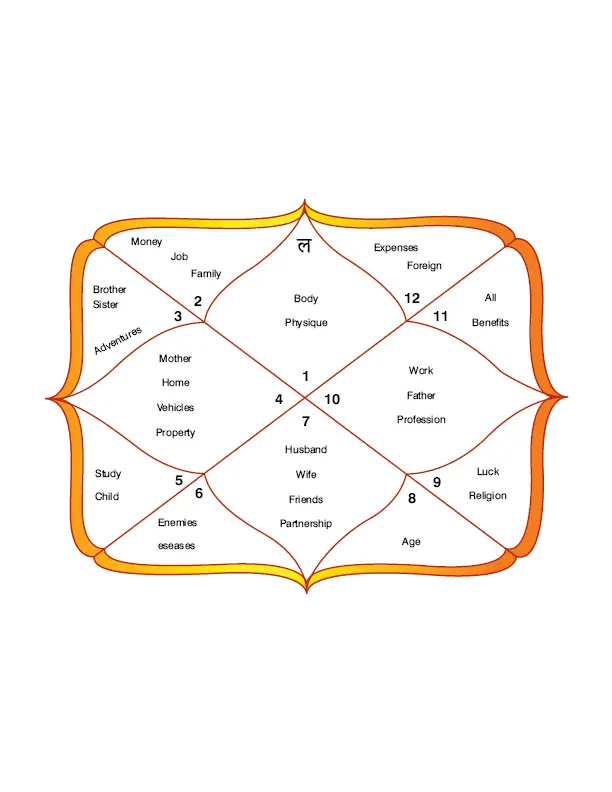In Indian culture, marriage is considered a sacred union that brings two individuals and their families together. Kundli matching, also known as horoscope matching, plays a significant role in assessing the compatibility of the prospective bride and groom. Among the various methods used for compatibility analysis, the Ashtakoot system is widely employed.
The Ashtakoot system assigns numerical points to eight different aspects of the horoscopes, indicating the level of compatibility between the couple. Let’s delve into the intricacies of the 8 Ashtakoot points and their significance in Indian Kundli matching.
Varna (1 point)
Varna refers to the spiritual and intellectual compatibility between the couple. It assesses the temperament, behaviour, and nature of the individuals. The four varnas are Brahmin (priestly class), Kshatriya (warrior class), Vaishya (merchant class), and Shudra (labourer class). Higher compatibility in Varna suggests that the couple’s spiritual and intellectual inclinations align well, resulting in a deeper understanding and harmony between them.
Varna koota matching rule suggests that Brahaman Varna should be of the first order, followed by Kshatriya, Vaishya and Shudra. Apart from this, the varna of the bridegroom must be superior or the same as the bride’s for better points in the Guna system. In case the varna of the bride is superior, no point is added to the Guna system.
Vashya (2 points)
Vashya examines the dominance and control one partner has over the other. It determines the level of influence and attraction in the relationship. There are five Vashya categories: Manav (human), Vanchar (wild animals), Chatushpad (small animals), Jalchar (aquatic animals), and Keet (insects). Compatibility in Vashya indicates a sense of balance and respect within the partnership, where neither partner dominates the other excessively.
As the moon sign determines the innermost qualities of an individual, the vashya koota reveals the ease of comfort of the bride and groom with one another. If the bride and groom belong to the same group, two points are added to the Guna Milan system. If a bride’s rashi is Vashya or controllable to the bridegroom’s rashi, you can calculate it as one point. Similarly, if the bride’s Rashi is Bhakshya or esculent to the bridegroom’s Rashi, you can calculate it as 1⁄2 point in the system.
Tara (3 points)
Tara evaluates the health and well-being of the partners throughout their lives. It focuses on the longevity and physical well-being of the relationship. The compatibility of Tara koota can be calculated by continuing from the bride’s nakshatra to the groom’s nakshatra, and the remainder is divided by 9.
Moreover, the maximum points obtained shouldn’t be more than 3. If the remainder is an even number, it is a good match. Compatibility in Tara suggests a harmonious and long-lasting union where both partners can support each other in times of physical or emotional challenges.
Yoni (4 points)
Yoni analyses the sexual compatibility and intimacy between the couple. It represents the animal instincts and behaviour patterns of the partners. In the case of the same yonis of bride and groom, 4 points are calculated in the Gun Milan system. Similarly, points 3, 2 and 1 are added if the yonis are friendly, neutral and enemy to each other. Higher compatibility in Yoni indicates a fulfilling and satisfactory intimate relationship where both partners share a strong physical and emotional bond.
Graha Maitri (5 points)
Graha Maitri assesses the mental compatibility and friendship between the partners. It focuses on the relationship’s mutual understanding, communication, and emotional connection. Graha Maitri is the assessment of the moon signs of the bride and groom and is calculated as follows:
- If the rashes are in friendly signs, 5 points are assigned to the Graha Koota.
- In the case of one friendly Rashi and another neutral sign, 4 points are awarded
- If both ratios are neutral, 3 points are added.
- 2 points are added to the Guna Milan in case of one friendly and one enemy sign
- Similarly, 0 points are added to one neutral and one enemy sign.
Compatibility in Graha Maitri suggests a strong bond and compatibility at an intellectual and emotional level. It indicates that the partners can engage in meaningful conversations, support each other’s goals, and share a deep sense of trust and friendship.
Gana (6 points)
Gana examines the temperament and nature of the individuals. It categorised people into three groups: Deva (divine), Manushya (human), and Rakshasa (demonic). The Gana of a native is determined through their birth Nakshatra. If the bride and the bridegroom have the same gana, 6 points are awarded to the match.
Similarly, if the bridegroom is Deva gana and the bride is Manushya, astrologers award the match with 6 points. Five points are awarded to the bride and groom with Deva and Manushya Guna, respectively.
Compatibility in Gana signifies a harmonious balance in the partners’ personalities, leading to a stable and peaceful relationship. It suggests that the partners share similar temperaments, values, and approaches to life, thereby minimising conflicts and promoting a sense of understanding and compatibility.
Bhakoot (7 points)
Bhakoot evaluates the compatibility of the moon signs between the couple. It examines emotional and psychological compatibility. Higher compatibility in Bhakoot is believed to enhance the overall harmony and understanding in the relationship. Bhakoot matching suggests that both partners’ emotional needs and sensitivities are in sync, leading to a deeper emotional connection and mutual support.
Nadi (8 points)
Nadi focuses on the genetic compatibility and health of the couple’s progeny. It assesses the presence of genetic disorders or diseases that could be passed on to future generations. Compatibility in Nadi is crucial for a healthy and prosperous family life. It indicates that no significant genetic issues or health concerns may affect the well-being of the couple or their future children.
Wrapping Up
The Ashtakoot points provide a systematic framework for evaluating the compatibility between prospective partners in the Indian Kundli matching system. It is important to note that Kundli matching is just one aspect of a successful marriage, and other factors such as mutual respect, understanding, and shared values should also be considered. While the
The Ashtakoot system offers valuable insights; it is essential to approach Kundli matching with an open mind and consider it as a guide while choosing your partner for life. Apart from the Ashtakoot system, numerous other factors determine the compatibility of a bride and groom. Couples must consult astrologers to dive deeper into their astrological compatibility, before tying the knot, for a brighter future!









